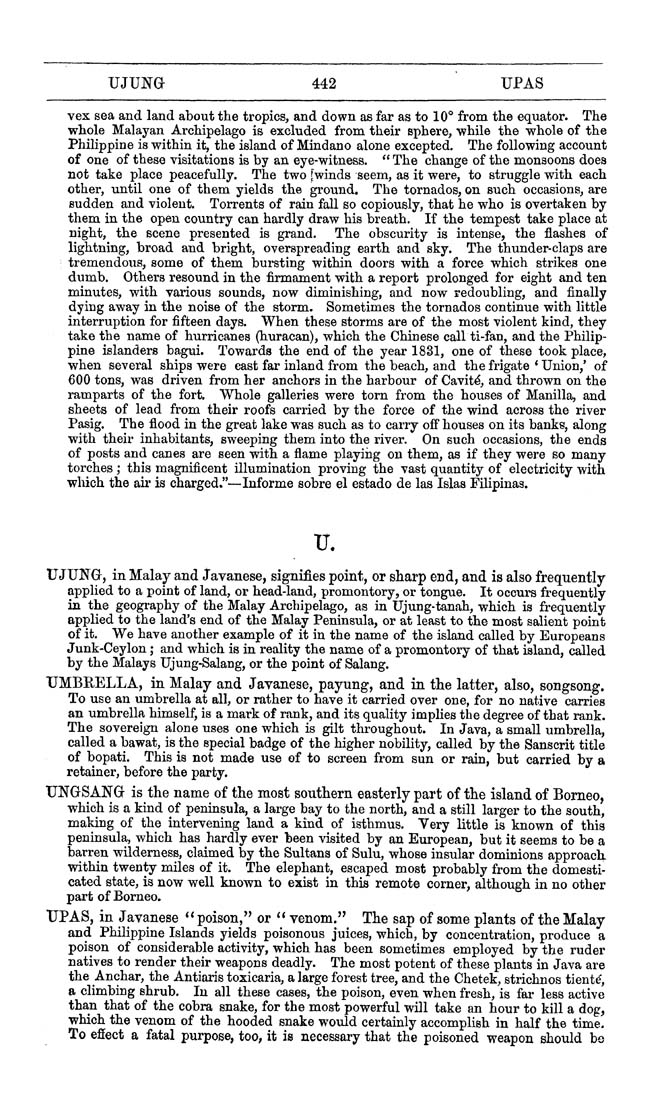UJUNG 442 UPAS
vex sea and land about the tropics, and down as far as to 10° from the equator. The
whole Malayan Archipelago is excluded from their sphere, while the whole of the
Philippine is within it, the island of Mindano alone excepted. The following account
of one of these visitations is by an eye-witness. " The change of the monsoons does
not take place peacefully. The two ^winds seem, as it were, to struggle with each
other, until one of them yields the ground. The tornados, on such occasions, are
sudden and violent. Torrents of rain fall so copiously, that he who is overtaken by
them in the open country can hardly draw his breath. If the tempest take place at
night, the scene presented is grand. The obscurity is intense, the flashes of
lightning, broad and bright, overspreading earth and sky. The thunder-claps are
tremendous, some of them bursting within doors with a force which strikes one
dumb. Others resound in the firmament with a report prolonged for eight and ten
minutes, with various sounds, now diminishing, and now redoubling, and finally
dying away in the noise of the storm. Sometimes the tornados continue with little
interruption for fifteen days. When these storms are of the most violent kind, they
take the name of hurricanes (huracan), which the Chinese call ti-fan, and the Philip¬
pine islanders bagui. Towards the end of the year 1831, one of these took place,
when several ships were east far inland from the beach, and the frigate * Union,' of
600 tons, was driven from her anchors in the harbour of Cavite, and thrown on the
ramparts of the fort. Whole galleries were torn from the houses of Manilla, and
sheets of lead from their roofs carried by the force of the wind across the river
Pasig. The flood in the great lake was such as to carry off houses on its banks, along
with their inhabitants, sweeping them into the river. On such occasions, the ends
of posts and canes are seen with a flame playing on them, as if they were so many
torches; this magnificent illumination proving the vast quantity of electricity with
which the air is charged."—Informe sobre el estado de las Islas Filipinas.
V.
UJUNG, in Malay and Javanese, signifies point, or sharp end, and is also frequently
applied to a point of land, or head-land, promontory, or tongue. It occurs frequently
in the geography of the Malay Archipelago, as in Ujung-tanah, which is frequently
applied to the land's end of the Malay Peninsula, or at least to the most salient point
of it. We have another example of it in the name of the island called by Europeans
Junk-Ceylon; and which is in reality the name of a promontory of that island, called
by the Malays Ujung-Salang, or the point of Salang.
UMBRELLA, in Malay and Javanese, payung, and in the latter, also, songsong.
To use an umbrella at all, or rather to have it carried over one, for no native carries
an umbrella himself, is a mark of rank, and its quality implies the degree of that rank.
The sovereign alone uses one which is gilt throughout. In Java, a small umbrella,
called a bawat, is the special badge of the higher nobility, called by the Sanscrit title
of bopati. This is not made use of to screen from sun or rain, but carried by a
retainer, before the party.
UNGSANG is the name of the most southern easterly part of the island of Borneo,
which is a kind of peninsula, a large bay to the north, and a still larger to the south,
making of the intervening land a kind of isthmus. Very little is known of this
peninsula, which has hardly ever been visited by an European, but it seems to be a
barren wilderness, claimed by the Sultans of Sulu, whose insular dominions approach
within twenty miles of it. The elephant, escaped most probably from the domesti¬
cated state, is now well known to exist in this remote corner, although in no other
part of Borneo.
UPAS, in Javanese *^ poison," or ^< venom." The sap of some plants of the Malay
and Philippine Islands yields poisonous juices, which, by concentration, produce a
poison of considerable activity, which has been sometimes employed by the ruder
natives to render their weapons deadly. The most potent of these plants in Java are
the Anchar, the Antiaris toxicaria, a large forest tree, and the Chetek, strichnos tiente',
a climbing shrub. In all these cases, the poison, even when fresh, is far less active
than that of the cobra snake, for the most powerful will take an hour to kill a dog,
which the venom of the hooded snake would certainly accomplish in half the time.
To effect a fatal purpose, too, it is necessary that the poisoned weapon should be
|








